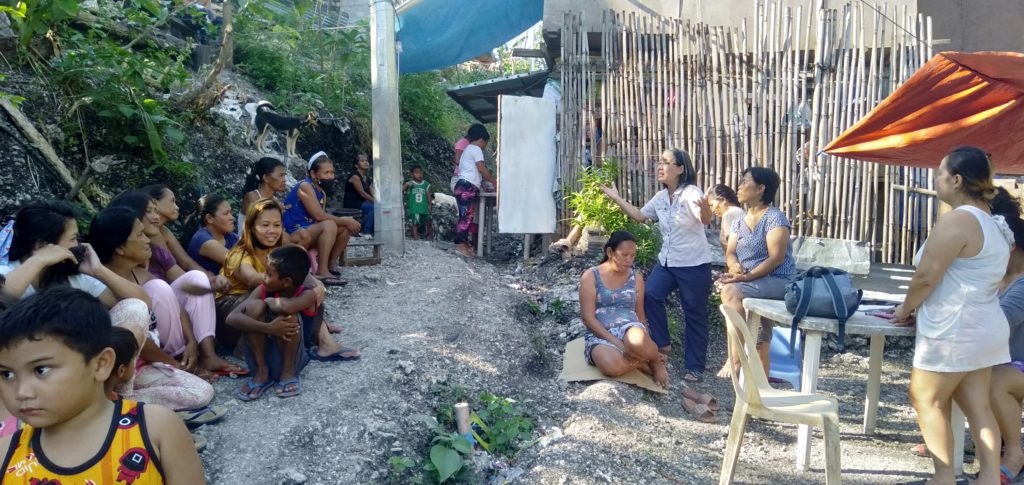The Visayas Primary Health Care Services, Inc. is currently in the second year of implementing its primary health care project supported by the Committee of German Doctors for Developing Countries.
The project, entitled, “Sustaining community-based health programs to promote health and prevent disease in urban poorcommunitiesin Cebu,” is implemented in PurokTambis, Barangay Umapad, Mandaue City with 125 households, Sitio Sawsawan, Barangay San Roque,Talisay City with 350households, and Sitio Intramuros, Barangay Poblacion, Muncipality of Cordova with200households.
The first year of the project started in May 1, 2016 and ended in April 30, 2017. The second year shall end on April 30, 2018.
In the past project, we trained a total of 45 community health workers in the three areas on basic health skills that will enable them to provide simple preventive, promotive and selective curative health services to their communities. The trained CHWs also rendered services during the rolling clinics where they searched for the patients’ records, took the weights, blood pressure, pulse rate, temperature, ushered them to the German doctors and helped in dispensing medicines. They also accompanied patients suspected of having tuberculosis to the health centers for sputum examination and patients referred by the German doctors to tertiary hospitals for proper care. Health teachings using the project health education materials were also rendered by the CHWs before the start of the rolling clinics.
In between rolling clinics, the CHWs did home visitations and conducted simple health teachings applying what they learned in the trainings. For instance, during the home visitations, the CHWs taught mothers with children who have cough and cols to give the children more fluids and extra nutrition, herbal plants such as lagundi, tamarind and calamansi.
Mothers of children with diarrhea were advised by the CHWs to use homemade oral rehydration salt solution, and to ensure cleanliness in the house and proper disposal of garbage and wastes, and proper storage of household water for drinking.
The CHWs also made herbal medicines including a liniment made of garlic, ginger, and red pepper for osteoarthritis and muscle pains, an ointment made of temple flower, moringa and hemlock for skin infections, lagundi syrup for cough and colds and ginger powder for tea.
Together with the project staff, they also conducted monthly health education classes using tarpaulins and leaflets on hypertension, tuberculosis, nutrition, diabetes, care of child with cough and diarrhea, and dengue fever.
A campaign on control and prevention of hypertension is ongoing wherein CHWs take blood pressure of residents in their homes, and refer hypertensive patients to the rolling clinics and health centers. The CHWs have also started to sell antihypertensive medicines bought at P 1.00 to P 2.00, at cost so that patients do not anymore have to spend for the fare going to the government health centers to get medicines which often times, run out of stock. Blood testing to screen for diabetes mellitus and monitor the blood sugar levels of diabetics has also been conducted and anti-diabetic drug at P 1.00 per tablet are also sold at cost by the CHWs.
A nutrition program was also launched. Children less than six years old in the three areas were weighed, so that the underweight and severely underweight were identified and their mothers advised on proper nutrition. Vegetable gardens in the three areas have also been cultivated with eggplant, bitter gourd, lady finger, and squash using seeds distributed to them by the project.
The second year shall sustain these activites. Furthermore, another basic health skills training shall be conducted for the trained CHWs.
The topics will be common diseases in their areas, diagnosis, prevention and management. They include simple cough and colds, pneumonia, diarrhea, influenza, skin infections and malnutrition in children, non ulcer dyspepsia, arthritis, hypertension, musculo-skeletal problems, tuberculosis, and diabetes mellitus. The training will discuss the common presenting symptoms and signs and how to examine patients with these problems.
Training materials including photocopied reading materials on the topics in the trainings shall be distributed to the participants.
A special skills training shall be conducted to cover two topics, namely, (1) effective leadership and health program management, and (2) resource generation.
With effective leadership and skills in health program management, the CHWs will be more effective in organizing their various activities including the health education classes, recruit residents to attend them, and mobilize them to get involved in the health campaigns such as the nutrition program. Leadership and program management skills will also enable the CHWs to know how to monitor and evaluate their project activities, document the number of participants, keep all patients’ records in order, and make monthly reports.
Furthermore, the teaching, learning and communication skills (TLCS) inputs in the training shall enable the CHWs to be effective health educators, to speak in public such as during health education classes, to come up with information materials, teaching aids, and deliver health messages effectively whether to an individual or to groups.
Resource generation shall teach the CHWs how to develop networks and tap government agencies and non-government organizations for material, human, financial and technical support for their various health activities. For instance, in their nutrition program, they can tap charitable organizations such as Feed the Children to provide them with a continuous supply of food for their malnourished children. Or, for their agricultural sources of food, they can tap the Department of Agriculture of the Philippine government to provide them with a wide variety of seedlings of vegetables.
For their sources of essential medicines such as antibiotics and anti-hypertensive medications which are often limited in stock in the government health center, they can tap pharmaceutical companies which give away medicines as part of their corporate social responsibilty. These and many other possible sources of resources shall be discussed.



